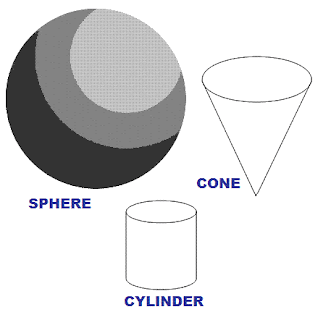Questions
- What is a form?
- Do you remember what a geometric shape is? Name me some.
FORM and VOLUME___________________________________________________________
Form is an element of art. At its most basic, a form is a three-dimensional geometrical figure (i.e.: sphere, cube, cylinder, cone, etc.), as opposed to a shape, which is two-dimensional, or flat.
A form always has three dimensions; length, width and height. When you stand next to an object you can go round it and see the three dimensions.
Volume (three-dimensionality) can be simulated in a two-dimensional work (like a drawing) thanks to the use of light and shadows, perspective, etc.
SOLIDS_______________________________________________________________________
SOLIDS_______________________________________________________________________
Solids are
three dimensional rigid bodies that occupy some volume or capacity. Solids have
length, width and height.
Type of
Solids:
- Polyhedron: regular and others.
- Non Polyhedron
1. Polyhedron
is a geometric
solid in three dimensions with flat faces and straight edges. Each surface is a
polygon.
2. Non Polyhedron: solids like cylinder, cone, and
sphere have surfaces which are curved or combination of both curved and flat
surfaces.
Name shapes and find out its equivalent volume, for example: a triangle would be a pyramid or a tetrahedron. What is the difference? (Regular or other polyhedrons)
A net of a polyhedron is an arrangement of edge-joined polygons in the plane which can be
folded (along edges) to become the faces of the polyhedron. Polyhedral nets are
a useful aid to the study of polyhedra and solid geometry in general, as they
allow for models of polyhedra to be constructed from material such as thin
cardboard.
Sculpture
Sculpture is three-dimensional artwork created by shaping or combining hard materials.
 |
| Chillida. El Peine de los Vientos. |
 |
| Rodin. The Thinker. |
Exercises____________________________________________________________________
- Look around you at different objects. Focus on only the light and dark areas and not the actual colours. Concentrate on the light and shadows. Then partly close your eyes until you see the values of that object.
- Make your own Polyhedron in a coloured cardboard. Check this page: Solid shapes and their nets.





This comment has been removed by a blog administrator.
ReplyDelete